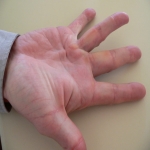So, you’ve noticed that you have these strange little bumps in the palm of your hand. They are thick and sometimes can be itchy or aching. Before things get out of hand, you contact your doctor and make an appointment to find out what these nodules are before they get any bigger. After a look and a feel of your hand, your doctor blurts out some crazy name you’ve never heard of, Dupuytren’s disease. Well what is that and is it serious?
Dupuytren’s disease

Dupuytren’s disease is a variably progressive condition that causes the connective tissue in the palm to become short and thick. Many patients will see a nodule begin to form in their hand, which eventually turns into a thick cord, and then progresses to the finger being stuck in a flexed position (contracture). It can be treated conservatively or surgically depending on the stage the disease is caught in. This blog series will aim to give you the upper hand about Dupuytren’s disease in its various stages, and treatment options that are recommended for each stage.
Who does it affect?
Dupuytren’s disease is typically seen in male patients over the age of 40. People of European heritage have the highest prevalence of this disease, including those in northern Scotland, Iceland, Norway, and even as far east as Australia. Other factors, such as the presence of diabetes, autoimmune diseases such as rheumatoid, and smokers are all predisposed to having Dupuytren’s disease of some degree.

It is important for your doctor to evaluate your hands to determine the underlying cause of any nodules you might feel in your hands. Things such as blisters, calluses, cysts, or other types of tumors could mimic a Dupuytren’s nodule. Even tendonitis could appear to be a superficial bump under the skin. Once you have been diagnosed with Dupuytren’s disease, treatment options should be discussed.
Without having pain or contracture, many doctors would recommend that you continue to monitor the nodule for any pain, thickening with cord formation, or contractures in the hand. The table top test helps keep track of the level of contracture in the hand. You simply lay your hand down on a table, if your palm does not make contact with the table, you should think about coming in for treatment. Pitting of the skin near the lumps is thought to be a sign of a cord forming that is starting to contract. Pitting can typically develop after nodules present themselves, but can happen independently from nodules. In our next blog, we will discuss the various stages of Dupuytren’s disease, and treatment options available for each stage.
Stay tuned!
Riki Duncan, ATC, LAT
Sources
http://dupuytrens-society.org.uk/information/dupuytrens-disease/symptoms/
http://www.aafp.org/afp/2007/0701/p86.html

